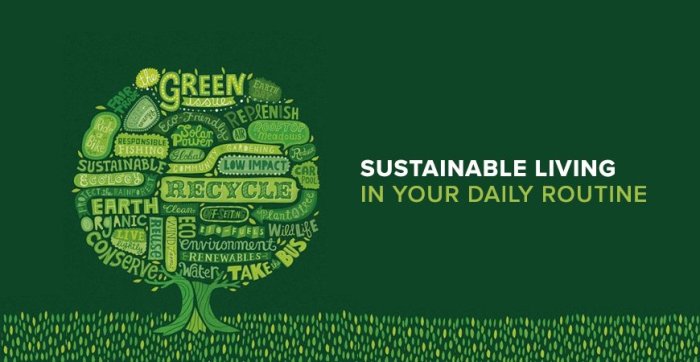Sustainable living is all the rage, y’all! Get ready to dive into a world where eco-conscious choices reign supreme, making sure you’re living your best green life.
Let’s break down the nitty-gritty details of what it means to live sustainably, from energy sources to food choices and everything in between.
Definition of Sustainable Living

Sustainable living refers to a lifestyle that aims to reduce one’s environmental impact on the planet by making choices that are environmentally friendly, socially responsible, and economically viable. It involves using resources in a way that preserves them for future generations.
Principles of Sustainable Living
- Reduce, Reuse, Recycle: Minimize waste by reducing consumption, reusing items, and recycling materials.
- Conserve Energy: Use energy-efficient appliances, turn off lights when not in use, and utilize renewable energy sources.
- Support Local and Organic: Buy locally produced and organic goods to reduce carbon emissions from transportation and support sustainable farming practices.
- Water Conservation: Conserve water by fixing leaks, using water-saving appliances, and reducing water usage.
- Transportation: Opt for walking, biking, carpooling, or public transportation to reduce carbon emissions from vehicles.
Examples of Sustainable Practices in Daily Life
- Composting food waste to reduce landfill waste and create nutrient-rich soil for gardening.
- Using reusable bags, bottles, and containers to reduce single-use plastic waste.
- Growing your own fruits and vegetables to reduce reliance on store-bought produce and support local food systems.
- Switching to energy-efficient light bulbs and appliances to reduce electricity consumption.
- Supporting businesses that prioritize sustainability and ethical practices in their operations.
Benefits of Sustainable Living
Living sustainably comes with a multitude of benefits that impact not only the environment but also social and economic aspects of our lives. By adopting sustainable practices, individuals can contribute to a healthier planet while also improving their overall well-being.
Environmental Benefits
- Reduction of carbon footprint: Sustainable living helps decrease greenhouse gas emissions, thus mitigating climate change.
- Preservation of natural resources: By using resources efficiently and minimizing waste, sustainable practices help conserve water, energy, and biodiversity.
- Promotion of cleaner air and water: Sustainable living leads to less pollution, resulting in improved air quality and water purity.
Social and Economic Advantages
- Creation of green jobs: The shift towards sustainability fosters the development of new industries and employment opportunities in renewable energy, eco-friendly technologies, and conservation efforts.
- Enhancement of local communities: Sustainable practices often prioritize local sourcing and support small businesses, strengthening community ties and resilience.
- Cost savings: Over time, sustainable living can lead to financial savings through energy efficiency, reduced waste, and lower healthcare costs associated with cleaner environments.
Improvement of Overall Well-being
- Health benefits: Sustainable living encourages healthier lifestyles through organic food choices, active transportation, and reduced exposure to harmful chemicals.
- Mental well-being: Connecting with nature, practicing mindfulness, and living in harmony with the environment can improve mental health and overall life satisfaction.
- Sense of purpose: Embracing sustainable living allows individuals to feel empowered and make a positive impact on the world, leading to a greater sense of purpose and fulfillment.
Sustainable Energy Sources
Renewable energy sources play a crucial role in sustainable living by reducing carbon emissions and minimizing environmental impact. Transitioning to clean energy sources is essential to combat climate change and ensure a sustainable future for the planet.
Solar Energy
Solar energy is harnessed from the sun’s rays through solar panels, converting sunlight into electricity. This renewable energy source is abundant, clean, and sustainable, making it a popular choice for sustainable energy production.
Wind Energy
Wind energy is generated by wind turbines that convert the kinetic energy of the wind into electricity. It is a clean and renewable energy source that is becoming increasingly prevalent in the energy mix of many countries worldwide.
Hydroelectric Power
Hydroelectric power is produced by harnessing the energy of flowing water to generate electricity. This renewable energy source is efficient, reliable, and environmentally friendly, making it a significant contributor to sustainable energy production.
Geothermal Energy
Geothermal energy is derived from the heat stored beneath the Earth’s surface, which is used to generate electricity or provide heating and cooling. This clean and renewable energy source offers a consistent and reliable energy supply with minimal environmental impact.
Importance of Transitioning to Clean Energy Sources
Transitioning to clean energy sources is crucial to reduce greenhouse gas emissions, combat climate change, and promote sustainable development. By shifting away from fossil fuels towards renewable energy sources, we can create a more sustainable and environmentally friendly energy system for future generations.
Innovative Technologies for Sustainable Energy Production
Innovative technologies such as energy storage solutions, smart grids, and advanced solar panels are revolutionizing the way we produce and consume energy. These technologies enhance the efficiency, reliability, and sustainability of renewable energy sources, making them key components of a sustainable energy future.
Sustainable Food Choices

When it comes to sustainable living, making conscious food choices is crucial. The impact of our food choices goes beyond just our health – it also affects the environment, economy, and society as a whole. By choosing sustainable food options, we can reduce our carbon footprint and support ethical practices in the food industry.
Tips for Reducing Food Waste
- Avoid buying more food than you need by planning meals and making a grocery list.
- Store leftovers properly to extend their freshness and avoid spoilage.
- Get creative with using food scraps in recipes or composting them instead of throwing them away.
Benefits of Organic and Locally Sourced Foods
- Organic foods are free from harmful pesticides and chemicals, promoting better health for consumers and the environment.
- Locally sourced foods support small-scale farmers, reduce carbon emissions from transportation, and ensure fresher produce.
- By choosing organic and locally sourced foods, we can contribute to a more sustainable food system and promote biodiversity.
Sustainable Fashion
Sustainable fashion is a movement and process of promoting clothing and accessories that are produced, marketed, and used in the most sustainable manner possible, taking into account both environmental and socio-economic aspects. It aims to minimize the environmental impact and social harm caused by the fashion industry, while still allowing consumers to enjoy stylish and quality clothing.
Environmental Impact of Fast Fashion
Fast fashion refers to the rapid production of inexpensive clothing that is based on current high fashion trends. This approach leads to overconsumption, massive waste, and exploitation of labor. The environmental impact of fast fashion includes high water usage, pollution from chemical dyes, greenhouse gas emissions, and textile waste in landfills.
- Fast fashion contributes to water pollution due to the use of toxic chemicals in dyeing processes.
- Textile waste from fast fashion items that are discarded quickly contributes to overflowing landfills.
- Greenhouse gas emissions from production, transportation, and disposal of fast fashion items contribute to climate change.
Tips for Building a Sustainable Wardrobe
Building a sustainable wardrobe involves making conscious choices that support ethical and eco-friendly fashion practices. Here are some tips to help you create a more sustainable wardrobe:
- Avoid impulse buying and prioritize quality over quantity.
- Choose clothing made from sustainable materials such as organic cotton, hemp, or recycled fabrics.
- Support brands that have transparent supply chains and ethical production practices.
- Invest in timeless pieces that can be worn for multiple seasons rather than trendy items.
- Repair and upcycle clothing to extend their lifespan instead of throwing them away.
Sustainable Housing
Sustainable housing plays a crucial role in reducing our carbon footprint and promoting a more environmentally friendly lifestyle. By using eco-friendly building materials and implementing energy-efficient design, we can create homes that are not only better for the planet but also more comfortable and cost-effective for homeowners.
Eco-Friendly Building Materials
- Bamboo: A fast-growing, renewable resource that can be used for flooring, furniture, and even structural elements.
- Recycled Steel: Durable and sustainable, recycled steel can be used for framing and roofing.
- Straw Bales: Excellent insulation material made from agricultural waste, providing energy efficiency.
Energy-Efficient Home Design, Sustainable living
- Solar Panels: Harnessing the power of the sun to generate electricity and reduce reliance on traditional energy sources.
- Proper Insulation: Ensuring that the home retains heat in the winter and stays cool in the summer, reducing energy consumption.
- Energy-Efficient Appliances: Using appliances with high Energy Star ratings to minimize electricity usage.
Making Existing Homes More Sustainable
- Upgrade Insulation: Adding insulation to walls, floors, and attics to improve energy efficiency.
- Install Energy-Efficient Windows: Double-paned windows with low-E coatings can reduce heat loss and gain.
- Water Conservation: Installing low-flow fixtures and using rainwater harvesting systems to reduce water usage.